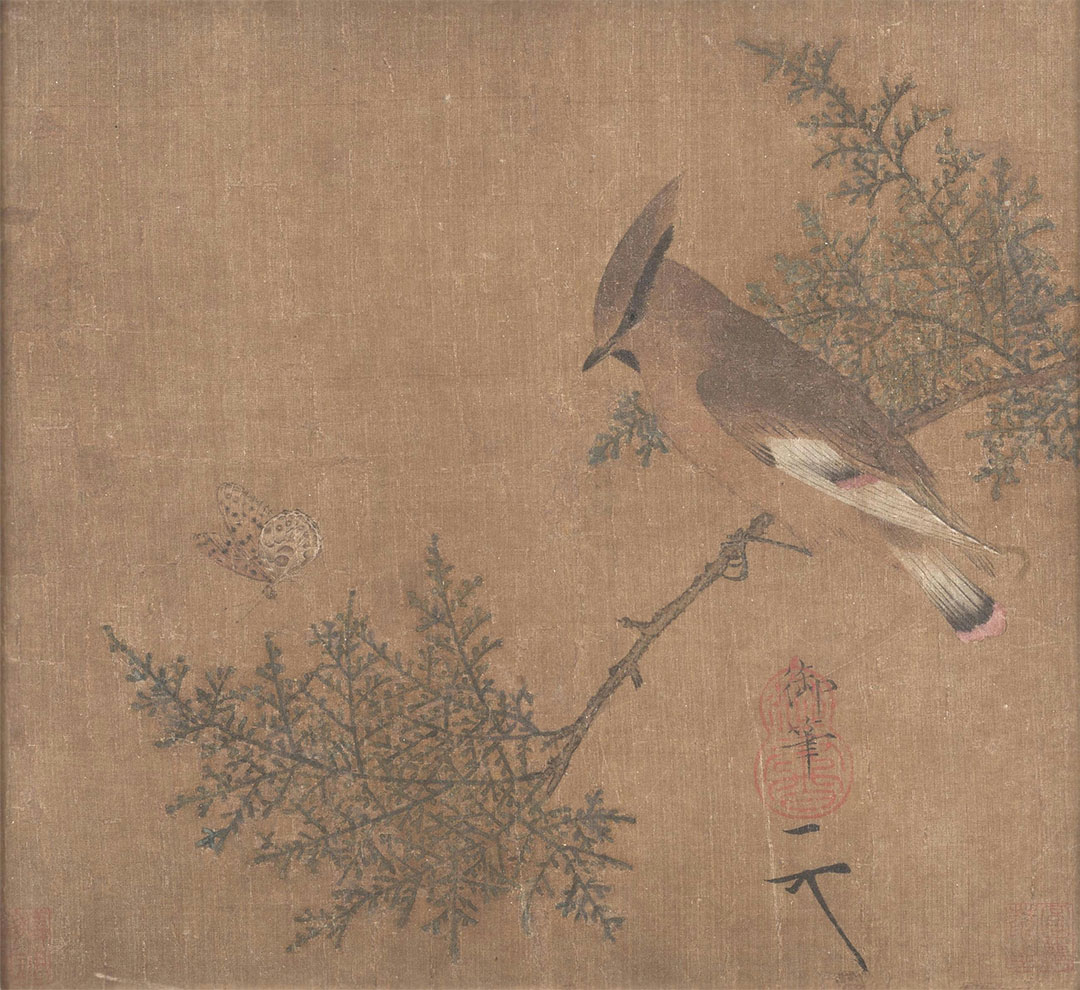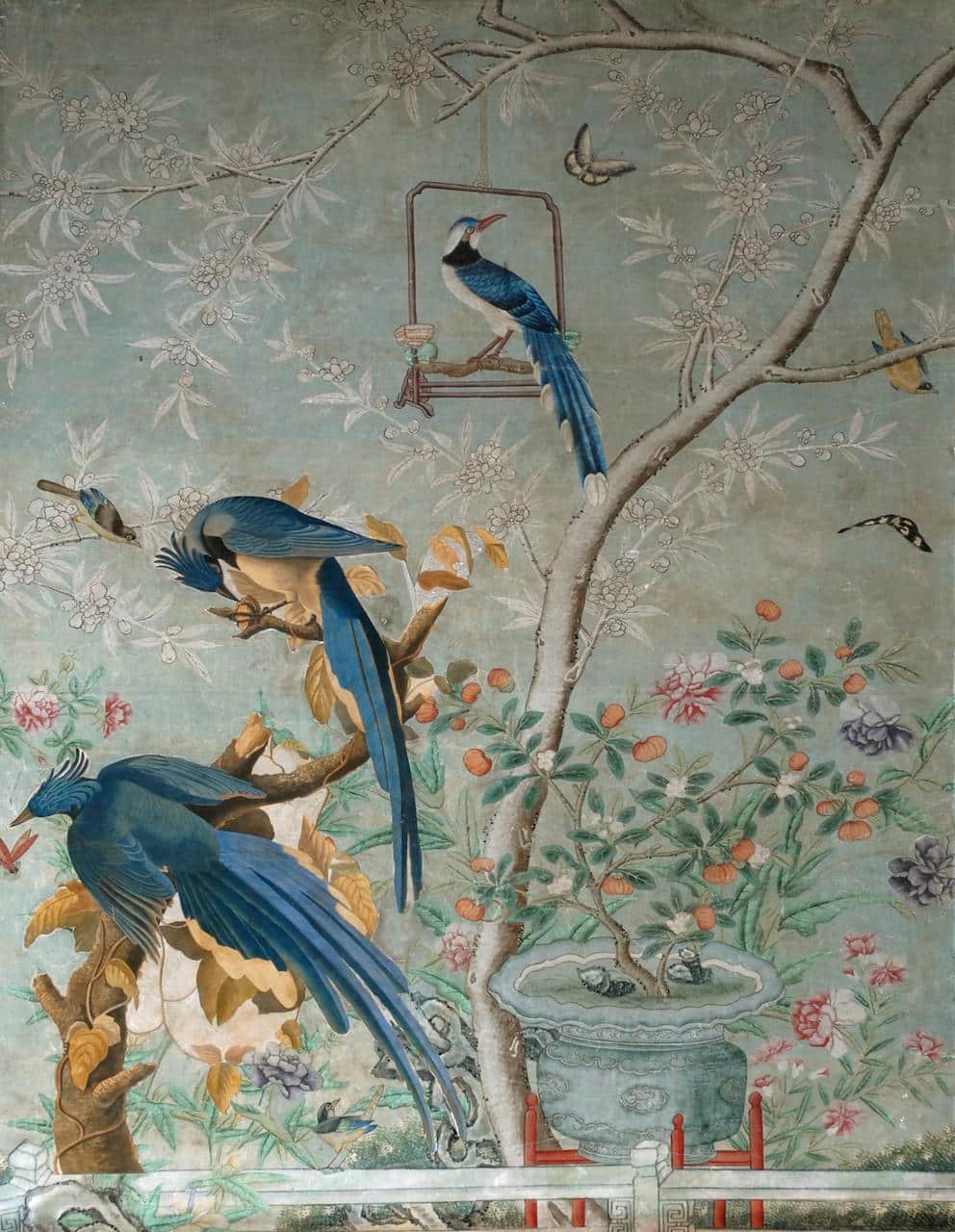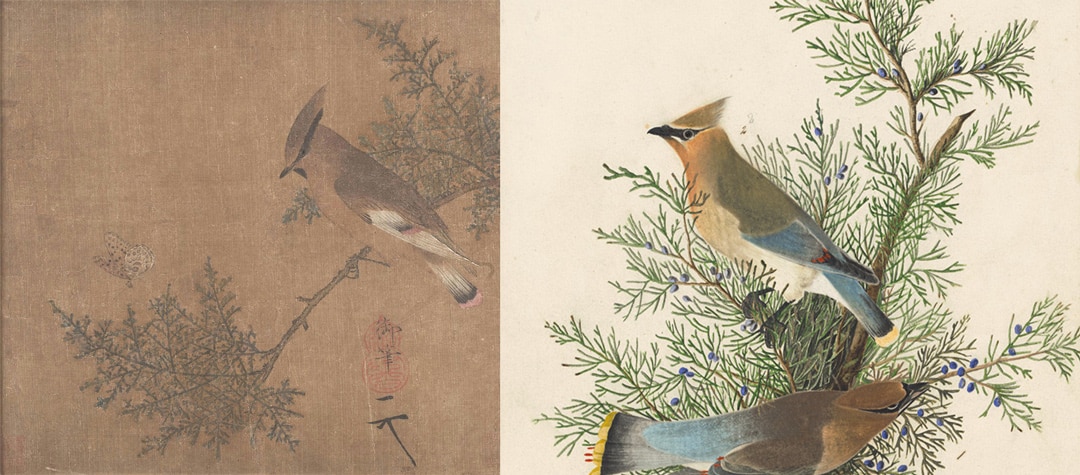Audubon Prints
The East Asian Influence in Audubon’s Art
A consideration of the increasingly globalized trade networks of the 19th century and their impact on Audubon’s visual lexicon.
As a transnational artist, Audubon was exposed to both the American and European cultural trends of his day. Though his biography informs us that he preferred the American backwoods to major cities, Audubon was raised in France, spent the majority of his life in America, and traveled extensively throughout Great Britain in order to work closely with his engraver, Robert Havell, and to gain subscribers for The Birds of America. As a result, Audubon’s art contains intonations and premonitions of the broader aesthetic and iconographic preferences of his day. Perhaps unexpectedly among these influences is the aesthetic impact of Asian art, namely Chinese textiles, porcelain, lacquers, and prints that took the European and American markets by storm and greatly impacted the aesthetic movements of the 18th and 19th centuries. Consequently, as a product of his time, Audubon was directly or indirectly exposed to these aesthetic preferences that permeated many facets of everyday life.

Audubon 1st Ed. Octavo Pl. 69 Townsend’s Ptilogonys
Image Box text

Loquats and Mountain Bird, by an anonymous painter of the Southern Song Dynasty (1127–1279).
Painting on Silk. Collection of the National Palace Museum, Beijing.
When comparing Audubon’s prints with Chinese art and imports, often made specifically for the European market, there are several distinct similarities between the two. Among these likenesses are the balance and rhythm of Audubon’s compositions, his graceful and calligraphic line quality, and his heightened focus on stylized and elevated representations of birds in their environment. Take for instance Audubon’s watercolor of the Long-tailed Jaeger and a Chinese silk scroll with Blue Magpies on it dated to the Ming Dynasty (1368-1644), tellingly housed in the Rijksmuseum. On first impression, the viewer is struck by the distinct compositional likeness between the two works of art. Both exhibit a strong diagonal schema through the posturing of the birds, as well as a graceful treatment of their forms.

Blue Magpies, anonymous, 1368 – 1644.
Ming-dynasty (1368-1644), China, silk dye. Rijksmuseum.

Audubon’s Watercolors Pl. 267, Long-tailed Jaeger
Early 19th century
Though it’s unlikely that Audubon would have encountered this exact print in Amsterdam, similar imagery was pervasive in Great Britain, France, and America throughout the 18th -19th century as a result of the increasingly globalized trade networks. In fact, the consumer preference for Chinese imported goods, termed chinoiseries, initially began with the reign of Louis XIV in the Rococo era and experienced a resurgence in the 19th century. A photograph of the interior of Victor Hugo’s Paris apartment aptly illustrates this taste for exotic imports. As a result of international trade, the French ornamental language was greatly influenced by the design and stylistic features of foreign goods. Likewise, Audubon’s visual repertoire exhibits a similar consciousness of these broader cultural trends through his use of elegant line work, balletic compositions, and the subject matter itself; elevated examinations of avifauna, that had long been a mainstay in East Asian art and ornament.

Chinese room in the house of Victor Hugo
Paris, Vassil Zairon
In addition to the visual and stylistic similarities between Audubon’s art and East Asian designs, the history of bird art itself was much more developed in China and Japan before it became an elevated genre in Western art. In his 1947 essay “Birds, I,” Alan Priest, Curator of Far Eastern Art at the Metropolitan Museum of Art, suggests that in European art “it was not until the eighteenth century that birds began to be pictured as really lively and important for themselves, represented in what are almost stage scenes of flowering trees and ornamental rocks.” He continues, “Was this a European invention? Of course it wasn’t. It must have been inspired by the importations of ornamental vases and wallpapers from the Orient. Our histories of art are well aware of the influence of Chinese art upon the decoration of the eighteenth century, but has it occurred to our naturalists that possibly it influenced their way of representing birds and flowers too?” (269).

Jay on a Branch
19th century, unknown artist, Chinese.

Audubon’s Watercolors Pl. 43, Cedar Waxwing
Early 19th century
A comparison of Audubon’s watercolor for Pl. 43, the Cedar Waxwing with the 19th c. Chinese album leaf Jay on a Branch, reveals a convincing confluence of creative mechanisms between the continents. In these works of art, the treatment of the subject matter is similar in that the bird-subjects are captured on a branch native to their habitat. Suspended against a blank background, our sole focus is lent to the intimate view of the birds without the distraction of a fully articulated background. As a result, the bird itself is elevated by this exclusive treatment. Moreover, Audubon’s crisp and definitive linework greatly resembles that of his Qing Dynasty antecedent.

Chinese wallpaper with Audubon’s Columbia Jay pasted on it
Lady Isabella Hertford’s Temple Newsam estate in Leeds

Audubon’s Pl. 20 Columbia Magpie or Jay
Havell edition engraving
The visual similarities between Audubon’s art and Chinese textiles were not lost on his clients, one of whom was Lady Isabella Hertford who pasted cut-outs of his Birds of America on her hand-painted Chinese wallpaper at her home, Temple Newsam in Leeds. Termed “one of the costliest home crafting projects in history,” Hertford collaged a number of the bird elements of Audubon’s prints onto her already costly wallpaper. The results are surprisingly coherent and the birds, Audubon’s Columbia Magpie or Jay, do not seem out of place in the original floral and avian arrangement.
Lastly, it is notable that in 1854 Commodore Matthew C. Perry brought four volumes of Audubon’s double-elephant folio of Birds of America and three volumes of his Quadrupeds to Japan as gifts for the Japanese authorities in an attempt to establish good diplomatic relations. The gifts were chosen not only as instructive mechanisms to display the beauty and breadth of American wildlife, but also because United States officials assumed that the prints would be well-received by the Japanese. This decision further suggests that Audubon’s work was perceived as containing resonances of Eastern Asiatic artistic principles.

Audubon Opening His Box of Watercolors Destroyed by Norway Rats, Unidentified Japanese Meiji artist,1872–77.
Ukiyo–e woodblock print on paper. Department of Prints, Photographs, and Architectural Collections, Bella Landauer Collection at the New York Historical Society.
In fact, print media generated from within Japan, such as this Meiji period Ukiyo–e woodblock print titled Audubon Opening His Box of Watercolors Destroyed by Norway Rats, confirms his popularity. Created by an unknown Japanese artists around 1872-77, this print visualizes an account recorded by Audubon in his Ornithological Biography in which an entire box of his watercolors was ransacked by a fleet of rats. Using his precious paintings as nesting material, the rats destroyed at least 200 works of art depicting “nearly a thousand inhabitants of the air.” Decades later, this story, along with Audubon’s renown, circulated to a global level such that a Japanese artist was inspired to represent it.
In conclusion, Audubon’s influences were vast and varied, permeating his consciousness from a multitude of sources. Furthermore, the pervasive presence of East Asian imports in Europe and America during the 19th century created a visual culture in which Audubon would have been hard-pressed to avoid their aesthetic influence. Consequently, we are left to assume that through direct contact or indirect affect, the ornament and design of imported material culture left an impression upon Audubon that is discernible in his art.

